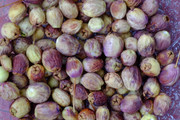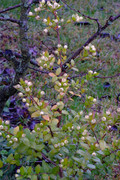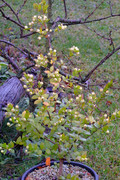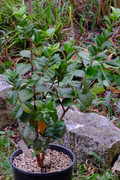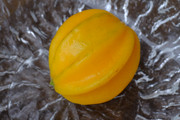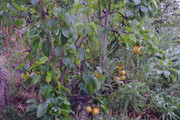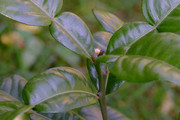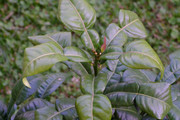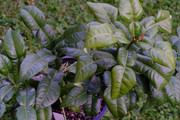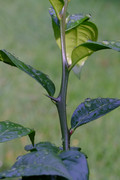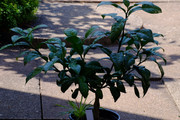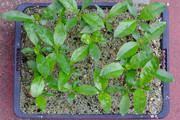This is my experience with Anacardium humile. I germinated 20 seeds in 2016. Seeds of Anacardium humile, obtained from Luc Vleeracker, usually germinate close to 100%. Already three days after sowing, the sand above the seeds stains dark and within seven days all plants are actively growing. These plants are very fast to come into life, but can be very fast to go. During the warm season, I grow my plants in a hoop house, with both ends permanently and entirely open for fresh air. All plants developed well until the end of summer. My first plants were dead in October, and by November, they were all gone. Dead, despite I watered very sparingly, as the autumn days became colder. 2017, I asked Luc to send me five seeds, only. I didn´t want to see 20 dying plants again. All five seeds germinated within a week, grew fast and looked happy. In September, before the first cold days approached, I potted four plants in a planter box with a water reservoir. The idea was, not to water the plants for the whole winter, so the roots stayed dry. However, to have some moisture in the subsoil. This would be a similar condition, like the plants would enjoy during the dry season, in its natural environment, in the Cerrado. I moved the planter inside the house in a room, heated at around 15°C (59° Fahrenheit) during winter, on a south facing window. In the planter was no space for the fifth plants. So I decided to keep this plant still in the hoop house, as sort of a control. Even, kept fairly dry and protected from frost, this plant was dead at the end of October. The other four inside plants still showed some grows, but stopped growing at around November, and started slowly to shed leaf after leaf, during the winter. By March 2018, the last leafs fell off. However, the stem itself was green, with a well-developed xylopodium at the base. All four plants leafless, but still alive. Some stems started to dry at the top. During a warm spell in March, on the now fairly warm and sunny window, several buds, situated mainly at the xylopodium, started to burst. Now, I decided to water. Was it too early, or was it too late? Anyhow, the weather became cool again and the shoots aborted. Moreover, the stems showed even more dieback. In April, two plants were dead and two plants alive and growing new leaves.
In May, the planter was moved in the hoop house again. There was no fast development in the second year. Did the plants change its character? Now, the plants grew fairly slow. Maybe, I didn’t I fertilize enough? I am not sure about this. The two plants grew steadily and gained more than its former strength.
Now, that winter is approaching, I am worried again. Maybe, it wasn´t a good idea with the planter. In a normal pot, soil moisture could be better controlled. Today, with the first cold day, I have moved the planter inside again.
In summary it can be said, that Anacardium humile likes a well-draining, acidic soil and plenty of water, as long as the plants enjoy a warm and sunny environment. It is a true tropical plant, which can survive colder temperatures in dry dormancy only. In nature, dormancy is initiated by shortness of water. Cold means for Anacardium humile, day max temperatures below approximately 15°C (59° Fahrenheit). Wet and cold, soon results in dead plants. Furthermore, the demand for dormancy is genetically fixed. Anacardium humile would not survive either, in all year warm, wet tropical biome, unless protected from rain. The large seed enables the seedling to a rapid growth. Seedling plants can survive the first dry season only, if established a large enough root system and xylopodium.
I do have a request. Luc, can you please show us a photo of your plant at the end of the dry season? Does your plant shed leaves during dormancy?
June 22, 2017. Seven days after sowing. Five seeds gave five plants. Garcinia seeds in the other pots, took much longer.
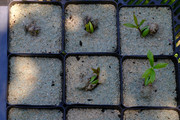
September 08, 2017. Not even three months old. The planter was moved inside.
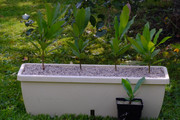
September 24, 2018. The left plant regenerated from the xylopodium, only. This plant developed several new stems, none as tall as the one last year, and a strong xylopodium. In the other plant, the whole stem survived, beside the very top part. New leaves emerged from the stem with an additional shoot from the xylopdium. The moss shows, that the plants were watered almost every day, during summer. There were seeding trays on top, beside the dead plants. The planter was moved inside, today.
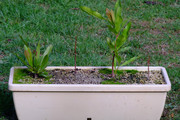
September 24, 2018. The above part of the xylopodium of the left plant produced many dormant buds. The xylopodium of the right plant looks similar, but is not as thick.




